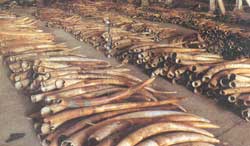The endangered Asian elephant
 The Indian delegation to CITES strongly opposed the list- ing of the African elephant in Appendix II and reopening trade in ivory, perceived as a threat to the Asian elephant. Ashok Kumar of the Wildlife Protection Society of India, who was part of the Indian delegation, says that carvers in Japan prefer Asian ivory, since it is stronger than African ivory, which is likely to crumble. He says that the price of Indian ivory has risen by 50 per cent in the last year, in anticipation of the lifting of the ban, and poach- ing has gone up dramatically in India. But African NGOs say that the decline in populations of the Asian elephant is due to improper management, and will not be affected by the lifting of the ban on ivory trade, particularly with the strict control measures that are to be followed once trade resumes.
The Indian delegation to CITES strongly opposed the list- ing of the African elephant in Appendix II and reopening trade in ivory, perceived as a threat to the Asian elephant. Ashok Kumar of the Wildlife Protection Society of India, who was part of the Indian delegation, says that carvers in Japan prefer Asian ivory, since it is stronger than African ivory, which is likely to crumble. He says that the price of Indian ivory has risen by 50 per cent in the last year, in anticipation of the lifting of the ban, and poach- ing has gone up dramatically in India. But African NGOs say that the decline in populations of the Asian elephant is due to improper management, and will not be affected by the lifting of the ban on ivory trade, particularly with the strict control measures that are to be followed once trade resumes.
On paper, the Indian population of elephant has all the laws it needs for protection. The Indian Wild Life Protection Act (1972) banned domestic sale of ivory and its products in 1986. In 1991, by an amendment aimed at stopping sale of Asian ivory under cover of African ivory, the import, carving and sale of the latter were also banned. As a signatory of CITES, import and export of ivory had already been banned in India since 1976. But poaching cases have increased over the years (see graph: Hunted down).
A recent report released by the Asian Elephant Conservation Centre says that in the past, Asian ivory was laundered with the import of African stock. So while the figures in Kenya show an official export of 21 tonnes of 1vory in 1970-77, the Indian figures for the same period is 118 tonnes. Tanzania did not show any export of ivory to India for the years 1979-81, while the Indian figures show imports of 605 kg, 1499 kg and 1997 kg of tusks in 1979, 1980 and 1981, respectively.
Related Content
- People’s attitude towards wild elephants, forest conservation and Human-Elephant conflict in Nilambur, southern Western Ghats of Kerala, India
- Order of the Supreme Court of India regarding death of elephants because of railway accidents, 02/09/2014
- India State of the Environment Report : The Monthly Overview, September 2013
- Gangetic River Dolphin, Dugong are now high-priority for conservation
- Corbett reserve faces a host of intractable problems
- Declaring area around Dalma wildlife sanctuary as eco-sensitive zone
